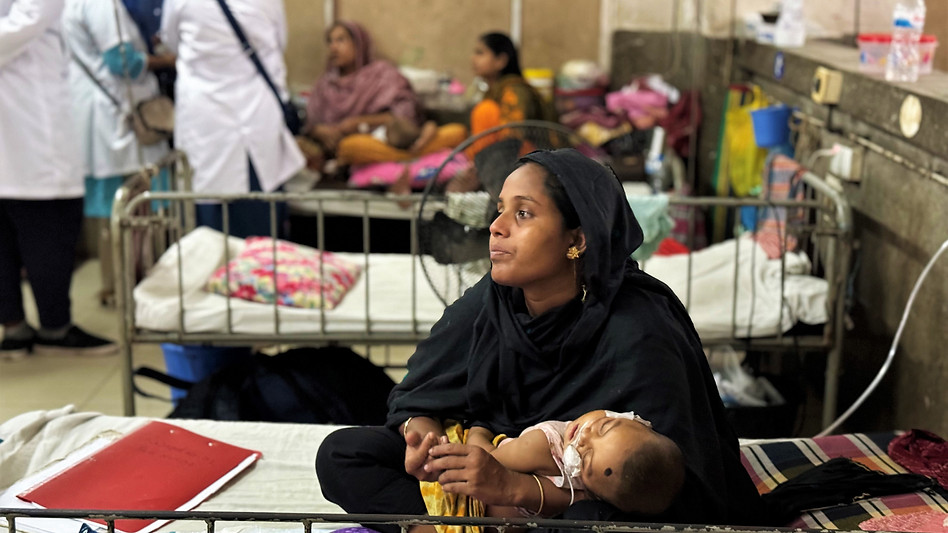
Extreme heat brings fast-rising risks for pregnant women and babies

By Laurie Goering - August 2025
Increasingly extreme heat around the globe is driving a surge in premature births and stillbirths, as well as pregnant women suffering dangerous health conditions such as preeclampsia and gestational diabetes, even if their exposure to heatwaves is relatively brief, researchers say.
Heatwaves can increase the odds of early birth by 9-18 percent, and heat exposure in the first half of pregnancy can boost the odds of developing preeclampsia or eclampsia by more than 50 percent, said researchers at the London School of Hygiene and Tropical Medicine (LSHTM).
Extreme heat may also boost the likelihood of newborns suffering disorders ranging from spina bifida and kidney problems to head and face defects, researchers found.
The problem is worst in low-income and middle-income countries, where people and their health systems often lack the resources to adapt and stay cool, but “heat is impacting the high income as well as the low-income. The health impacts are happening across the board,” warned Debra Jackson, one of the lead authors of a paper published in August 2025.
It calls for a range of action to try to limit the growing health threats, including promotion of “passive” cooling measures such as reflective white roofs to keep homes and clinics cooler, development of effective heat early warning systems, more attention on women and children’s health in national climate change adaptation plans and better training in the heat-related health threats for healthcare workers, who themselves are struggling in extreme temperatures.
Right now “the hospitals are just hot, and we’re seeing a definitely impact on the quality of care,” said Jackson, a global maternal and child health professor at LSHTM who is carrying out research in southern Africa.
“Mothers talk about labouring in this kind of heat, and midwives work in that heat too. On one of our site visits the midwives thanked us for thinking of them - they said no one thinks of them,” she added.
RISKS TO WOMEN
The new paper, which brings together research around the world on maternal and child health threats from climate change, says women are dealing with a disproportionate share of climate stresses including extreme heat.
“Millions work as hard as, or harder, than men while also caring for offspring and elderly parents. Many continue to engage in farming and other outdoor or household work, such as collecting water and cooling, when they are pregnant,” researchers noted.
As well, women and children - anywhere in the world - live in poverty at a much higher rate than men and “they have less personal resilience and ability to adapt because of that,” Jackson said.
Pregnant women - as well as young children - are also less physiologically able to cope with heat, though health researchers are still struggling to pin down precisely how excess heat is causing problems such as gestational diabetes or preterm births.
“It’s a perfect storm, with pregnant women and children most vulnerable but least likely to have the resources to do something about that,” Jackson said.
“A woman who has to go to the field or her family doesn’t eat can’t take the day off or sit in the air conditioning and put her feet up, because she doesn’t have air conditioning and she can’t afford to put her feet up.”
In one farming community in the Gambia, in West Africa, research shows pregnant women today face high levels of heat 30 percent of the time, with many complaining of nausea, dizziness and other signs of heat stress. When tested, a third of their unborn babies were found to be under “acute” strain.
In Kilifi, on Kenya’s coast, new mothers - many living in small, windowless rooms also used for cooking - reported exhaustion from heat keeping their newborns awake, and problems in their children ranging from blisters to low birth weight. Many mothers said they felt irritable, anxious and dizzy in the heat.

finding answers
In Greece and the Gambia, researchers are now collecting the blood and urine of pregnant women and newborns in an effort to better understand precisely how heat is affecting bodily systems, in the hopes of developing new protections against rising risks.
Micronutrient supplements during pregnancy, for instance, might reduce the impact of heat on their health, Jackson said.
In Kenya, maternal health researchers are working with communities and families to help them understand that women in later pregnancy need more help with their jobs, especially when it’s very hot.
“You can’t tell a pregnant woman to drink more water when the water is a five-mile hike away in the heat,” Jackson said.
Early warnings of impending heatwaves could help avoid problems, allowing pregnant women and their families to, for instance, collect extra water on cooler days and avoid long walks in the heat, or plan strenuous farm work for moderate days.
In rural Zimbabwe and an informal settlement in South Africa, researchers are now testing a Mother Heat app, which sends messages to mobile phones warning of upcoming extreme heat, Jackson said. In areas where few people have phones, the warnings go to community health workers, who can share the alerts.
She said most communities are already well aware of increasingly extreme heat threats and eager to do something about them.
Women in areas where health researchers are working, given cameras to document the problems they face, have snapped images of swollen feet resting in buckets of water, children with heat rashes and women gathered in whatever shade is available.
When researchers proposed a study on painting roofs white to reflect more heat, “the community just said, ‘We can do that now - and they did,’” Jackson said.
“People feel the heat. They live it every day. They are thinking about it and very interested in understanding it,” she added.

low tech, low cost
In many cases, what is needed to deal with worsening heat is not new technological solutions but simply resources and willpower to put in place relatively low cost and already-known measures, such as boosting shade, improving airflow in buildings, planting trees, painting roofs white, and adding solar panels and battery systems to provide communities with energy for fans and to keep medicines cool, Jackson said.
A key treatment to stop women hemorrhaging after birth, for instance, only works if it is kept cold, she said.
Keeping women and children safer as heat extremes worsen also will require thinking about heat as just one of a wide range of climate impacts - including floods, storms and droughts - that can combine to cause problems for pregnant women and children, researchers said.
Droughts and crop failures, for instance, can hurt nutrition and cause micronutrient deficiencies, potentially worsening the impacts of heat on pregnant women and young children. Floods and storms that wash away roads and close hospitals also can affect maternal and child health, while excess heat can drive diseases such as yellow fever, dengue, Zika and schistosomiasis into new areas and new parts of the year.
WANING PROGRESS?
More research - including on heat threats in urban areas - and more specific tracking of women, children and other vulnerable groups in data sets already being collected could also help limit the coming threat from increasing extreme heat, Jackson said.
Studies of risks to workers from extreme heat often neglect subsistence farmers - many of them women - and indoor workers, such as women health workers and women working in South Asia’s many garment factories, Jackson said. That can slow efforts to better protect them.
“We’ve made good strides in reducing mortality and improving pregnancy outcomes” in many parts of the world, she said. But as climate change impacts including extreme heat strengthen, “that could completely reverse. All those gains could be lost and it could get worse over time.”
The threats aren’t limited to poor countries, the study noted, with women and children being affected everywhere from South Asia and Africa to Europe, where a study of 854 European cities showed increases in heat-related newborn deaths are expected to outstrip declines in cold-related deaths in years to come.
Worsening severe heat “is impacting everyone - it just depends on your personal and community resources and resilience and ability to adapt,” Jackson said.
But “women and children are particularly affected - and the potential economic cost and mortality cost for mothers and newborns is very high, and very scary. We need to pay more attention to this.”

